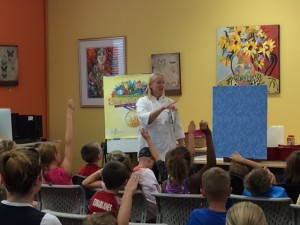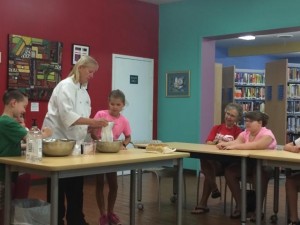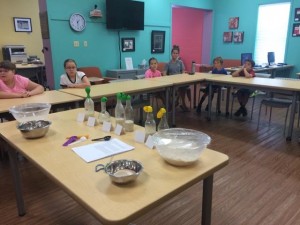Guest Post: Camp Wonderopolis® comes “Alive!” at Pottsboro Library
Six libraries across the nation were awarded $1,500 grants, NCFL training, and Youth and Family Campsite Kits to implement Camp Wonderopolis programming this summer, thanks to generous support from Better World Books. These libraries provided Maker activities exclusively found in the Youth and Family Campsite Kit and suggested book pairings for each of the six Camp Wonderopolis tracks online. In this guest blog post, Pottsboro Library (Pottsboro, Texas) shares how Camp Wonderopolis influenced its summer-learning programming:
It’s Alive! was the title of our second lesson of six Camp Wonderopolis sessions in our Food Science Program at the Pottsboro Library.
 We invited a student chef in the culinary arts program at Grayson College to host wonder-filled lessons for our children that combine food and science. In this lesson, we learned that the yeast we use in cooking is a living organism (just like us!) that remains dormant until it is “activated” by a certain environment. Grandmothers, parents, and children participated in this 45-minute session, which ended with a stir-and-pour bread recipe easy enough for the children to try at home.
We invited a student chef in the culinary arts program at Grayson College to host wonder-filled lessons for our children that combine food and science. In this lesson, we learned that the yeast we use in cooking is a living organism (just like us!) that remains dormant until it is “activated” by a certain environment. Grandmothers, parents, and children participated in this 45-minute session, which ended with a stir-and-pour bread recipe easy enough for the children to try at home.
We started this particular session with an activity found in the Youth and Family Campsite Kit called, “It’s Alive!” Volunteers mixed two batches of bread with pre-measured ingredients—one with yeast and one without, both using the correct water temperature. Each was placed in a clear bowl with plastic wrap covering. These bowls were placed on the demonstration table to be observed later in the program.
 In the meantime, six clear bottles were lined up on the demonstration table. We were going to see which temperature the yeast liked best and whether it is more active with food or without. We used cold (36°F), warm (110°F), and hot (160°F). Volunteers put one tablespoon of yeast into each bottle. In three of the six bottles, they put in 1 tablespoon of sugar (the yeast food). We then filled two bottles with cold water, two with warm, and two with hot water. Each water temperature also had sugar in one of the bottles. Balloons were placed on the bottles to measure activity. Table tents identified the ingredients/temperature in each bottle.
In the meantime, six clear bottles were lined up on the demonstration table. We were going to see which temperature the yeast liked best and whether it is more active with food or without. We used cold (36°F), warm (110°F), and hot (160°F). Volunteers put one tablespoon of yeast into each bottle. In three of the six bottles, they put in 1 tablespoon of sugar (the yeast food). We then filled two bottles with cold water, two with warm, and two with hot water. Each water temperature also had sugar in one of the bottles. Balloons were placed on the bottles to measure activity. Table tents identified the ingredients/temperature in each bottle.
It didn’t take long for the balloon on the bottle with hot water to expand. There were guesses that it was actually steam that created that reaction. The balloons on the cold bottles didn’t change. After a while, the balloon on the bottle of warm water with yeast and sugar started to expand and bubbles/foam were observed in the bottle. There were questions about whether the reaction would be strong enough to make the balloon shoot off the bottle. The balloon on the bottle of hot water deflated after its initial activity.
We had a discussion about yeast being living a organism that needs to eat (sugar in this case) and needs the proper temperature to thrive. Too cold, and the yeast won’t activate. Too hot, and the yeast will die. One mom said that she finally understood why her bread making attempts had never given her the results she hoped for. No one had ever explained the importance of the liquid temperature. It was also explained that yeast vary depending on what is in the air. The chef compared the yeast to the story of Goldilocks and The Three Bears when she ate the porridge. The first one was too cold, the second one was too hot, and the third one was “just right”!
 Then, a loaf of bread was cut in half and passed around so everyone could observe the holes, or air pockets, in the bread. Here, we learned that yeast makes the dough expand by putting off carbon dioxide and then is killed off by the heat of the oven.
Then, a loaf of bread was cut in half and passed around so everyone could observe the holes, or air pockets, in the bread. Here, we learned that yeast makes the dough expand by putting off carbon dioxide and then is killed off by the heat of the oven.
The class then had drops of warm water placed on their wrists to learn what the proper temperature is in case a thermometer isn’t available. The instructor pointed out that testing the temperature on the wrist is more accurate than putting your finger in the water because fingers aren’t as sensitive. If the water is too hot for you, it’s too hot for the yeast.
The batches of bread made at the beginning of the class were then passed around. The dough with yeast had bubbles and had risen. It also had a distinctive, wonderful smell. The dough with all the same ingredients minus yeast hadn’t changed shape and didn’t have the same aroma as the other.
 At the end of the program, everyone took home a bread-making kit we had purchased with our Camp Wonderopolis grant. The kit included all the pre-measured ingredients along with the recipe. All they had to do was add the liquid ingredients. Recipe card holders were made using binder clips and stickers.
At the end of the program, everyone took home a bread-making kit we had purchased with our Camp Wonderopolis grant. The kit included all the pre-measured ingredients along with the recipe. All they had to do was add the liquid ingredients. Recipe card holders were made using binder clips and stickers.
After the class, I received this email from one of the families. “If you happen to speak to Chef, please let her know that we made the bread with egg & cream tonight and it was WONDERFUL! The loaf rose beautifully, and we ate the whole thing in one sitting. Thank you for offering such wonderful programs at the Pottsboro Library. We thoroughly enjoy them! (intellectually & gastronomically!)”
Camp Wonderopolis is a virtual camp and online learning tool created by NCFL, which is available year-round to all families, libraries, schools, and community organizations.